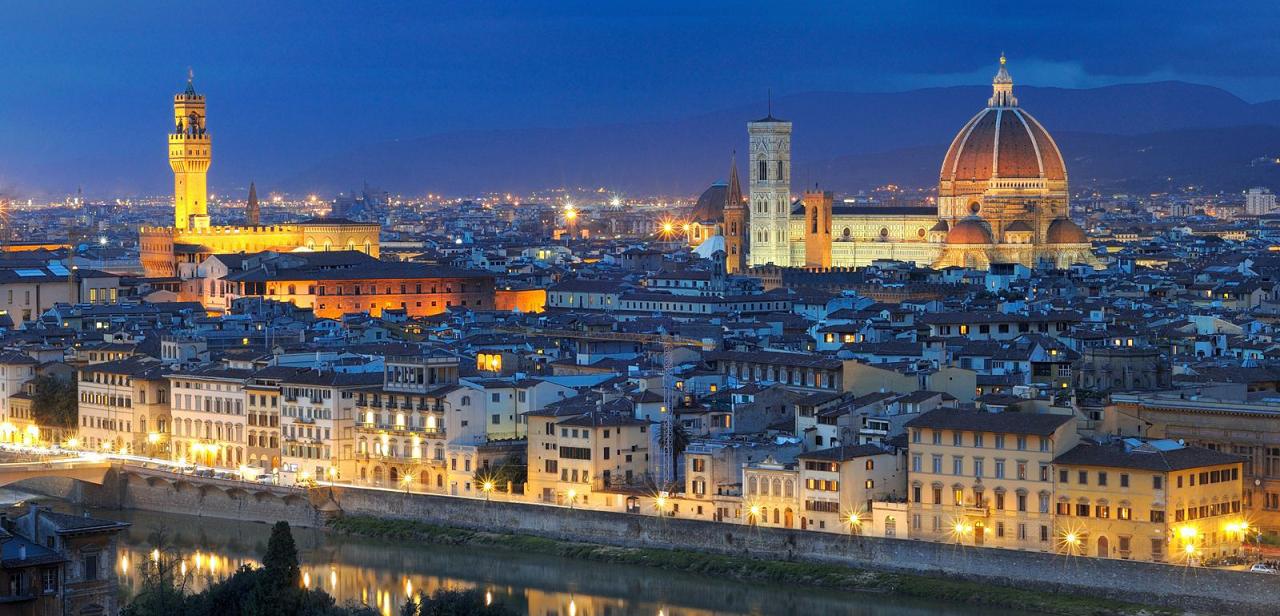Travel and Tourism in Florence Italy

The history of the city dates back to the first century BC, when Florence was founded by the Romans. In the Middle Ages, after a period of decline during the “dark ages”, the city began to flourish again under Carolingian rule, reaching highpoints of civilization between the 11th and 15th centuries when, as a free Comune, it managed to maintain a happy balance between the authority of the Emperors and that of the Popes and to weather the turmoil ensuing from the intestine struggles between the Guelphs and the Ghibellines.
In the 15th century it came under the sway of the Medici, who subsequently became the Grand Dukes of Tuscany. This period, known as the Renaissance, marked the peak of the city’s cultural, artistic, political and economic splendour. The Medici were succeeded, in the 18th century, by the Grand Dukes of Lorraine, who governed until the unification of the peninsula in 1860. From 1865 to 1871 Florence was the capital of the newly formed Kingdom of Italy.
Florence the city of art. No Many cities in the world introduce one complex personality like Florence. A visit of few days or of a single day, as it happens above all in the scholastic tourism, concurs of having one first impression of the city and to admire fastly someone of its many beauties.
It does not allow instead penetrating in the personality of the city, in that one of the past like in that one of the present. In order to hope to understand the deep spirit of the city and be conquered are therefore necessary repeated visits of some day and in the time.
For much people Florence it is the city of the art, a place in which the beautiful is at home. And in effects, if we think that approximately a tenth one of national artistic works is concentrated in Florence, this diffused impression appears very founded. Also a visitor moderately acculturated or however not distracted immediately see how much width is the area in which are stretched the numerous churches, the palaces private or publics of important interest, the roads in which the homogeneity of woven building and the light repeated changing of the roofs are transformed in unmistakable perspectives.
That immense area corresponds to that superficial enclosed in the third and more width circle of walls, constructed between the end del the 1200's and the beginning del the 1300's (the years of Dante, Giotto, Arnolfo di Cambio), when the city with its one hundred thousand inhabitants, was one delle four or five most important city of Italy and Europe. Of this only remain, for the demolitions of the second half of the 1800's, at the time of Florence Capital, the feature of Oltrarno, nearly integral, and, here of Arno, the tower of the Zecca and the three doors remained isolated in the squares created along the principal avenues.
Exist some aspects of actual Florence, that often escape also to the careful visitor, and in some case, also to the fiorentini. If Florence is in fact an art city, it is not only this, is not a city-museum, but Florence is a city rich of things to discover, not excluded the typical food, that it is characterized for its simple flavours as the 'bistecca alla fiorentina' and the optimal Chianti wines of the region.
And we do not want to refer, speaking about things to discover, to those fields of the handicraft and the commerce connected in the first place, or at least in part, with the tourism, and also important, like the fashion, in the last years however in crisis in favor of other cities, or like the jewels of Old Bridge and adjacent ways, or like the production and sale of embroiderys and objects of skin and straw, or like sure handicraft fields of quality, last patterns of the most glorious passed to handcraft (tasks to the carpenters restorers), or like the many storees of antique dealing.
We want rather to refer to Florence like city of the studies and the research. We do not only think, in saying this, to the studies and the research in the most famous humanistic fields, than also seem therefore congenital to the historical characters of the city, but also to the scientific field.
In Florence operates in fact, with to the scientific faculties of the University, one net of great respect of research public agencies: CNR, with about ten institutes; Astronomical observatory of Arcetri; one section of the National Institute for Nuclear Physics; National Optical institute; Sèperimentali institutes of the ministry of the Agriculture and forestry.
For who is interested to science and to the history of science, Florence offers the Botanical Garden and Museum, a History Museum of science and the Museum de La Specola, of which we advise one nourished collection of anatomical models in wax.




